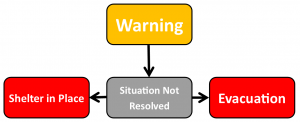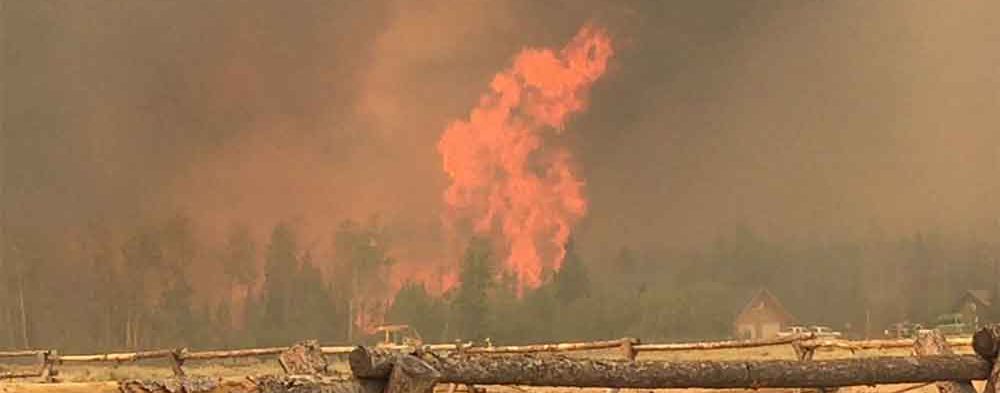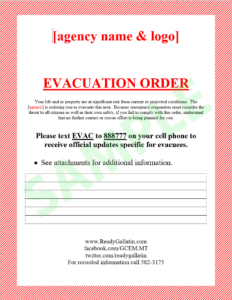Agencies in Gallatin County utilize a two step process in situations where it is, or may become, unsafe for people to remain in the area. This evacuation consists of two steps with a Warning and an Evacuation Order. We feel that it is much simpler to have two steps using plain language for the community to understand. Click Here for Montana Sheriff’s and Peace Officers Association’s Evacuation Best Practice.
Warnings
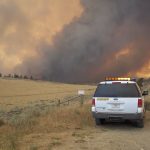 When a situation appears that it may become unsafe for people to stay in a certain location, a Warning will be issued. We try to provide advanced warning when possible with a Warning, however it is not always possible to provide a warning prior to an Evacuation Order.
When a situation appears that it may become unsafe for people to stay in a certain location, a Warning will be issued. We try to provide advanced warning when possible with a Warning, however it is not always possible to provide a warning prior to an Evacuation Order.
When someone receives a Warning, this is their notice that they should be ready to leave at a moments notice. In fact, if someone (or thing) will need extra time to leave, they should leave when they receive the Warning. This may be someone with special medical needs or livestock; if something can’t happen fast, then start it when you receive a Warning. If at any point you become uncomfortable, then you should leave. It is always better to have left too soon, than have it be too late to leave safely. Don’t feel you have to be told to leave!
Once receiving a Warning you should implement you Family Emergency Plan and make sure you are ready to leave on a moments notice. The intent of a Warning it to provide you the opportunity to take the steps you need to safely leave, so please take advantage of the opportunity.
Typically you will receive a Warning in person by a law enforcement official or other emergency responder, but sometimes this is logistically challenging and takes a while. You will often also receive a notification from our Community Notification System, but this also depends on the type of phones you have and if you have registered. Basically we will make every attempt to contact those in the affected areas through all available methods. When you receive a Warning it should be accompanied with additional information about what is going on and where you can obtain more information.
Evacuation Orders
If you receive an Evacuation Order, you should implement your Family Emergency Plan and leave immediately. Local officials don’t take evacuations lightly and if you are told to evacuate, there is a very good reason for it.
We will make every attempt to contact you in person with an Evacuation Order from a law enforcement officer or other emergency responder, if possible. Do realize, that in these situations things happen quickly and sometimes it is hard to reach everyone as quickly as we want. If at any point you feel uncomfortable with where you are, leave. You do not need to wait and be told by someone that you should leave.
 When you are told to evacuate, you will be provided additional information on the incident and what to do next. Once you leave, we do not want people coming and going as this creates more risk for you, your neighbors and the emergency responders trying to deal with the incident. In Gallatin County, you will not be forced to leave (except in a vary rare case under MCA 10-3-406(a)) by law enforcement. However, if you choose to stay you must stay on your property. You will not be allowed to come and go, nor will your friends and relatives. In large incidents like wildfire, many people have been killed after staying in their houses until the situation became worse than they expected and left when it wasn’t safe to do so (often injured due to traffic accidents). So, if you stay after being told to leave – don’t change your mind when conditions get worse. Remember, local officials have a reason they are telling you to leave.
When you are told to evacuate, you will be provided additional information on the incident and what to do next. Once you leave, we do not want people coming and going as this creates more risk for you, your neighbors and the emergency responders trying to deal with the incident. In Gallatin County, you will not be forced to leave (except in a vary rare case under MCA 10-3-406(a)) by law enforcement. However, if you choose to stay you must stay on your property. You will not be allowed to come and go, nor will your friends and relatives. In large incidents like wildfire, many people have been killed after staying in their houses until the situation became worse than they expected and left when it wasn’t safe to do so (often injured due to traffic accidents). So, if you stay after being told to leave – don’t change your mind when conditions get worse. Remember, local officials have a reason they are telling you to leave.
Shelter in Place
In situations where there is more risk from leaving the building they are currently in, they may be asked to Shelter in Place. When asked to Shelter in Place, you will be provided incident specific instructions, but ultimately we don’t want you leaving the building you are in. Shelter in Place is often used for situations like hazardous materials spills or when dangerous law enforcement operations are taking place in your neighborhood and it is safer for you to stay in side than coming outside. Usually this directive will be accompanied with instructions like lock all your doors and stay away from windows, move to the center of your home, shut off your heating system, seal door cracks with towels, and other similar actions.
Re-Entry
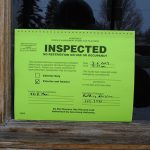 At the point in which it is safe for you to come back into the area, we will implement a re-entry plan for those who were affected. Depending on what the incident is, this can very from letting everyone in at once to a scheduled and escorted process. When you are contacted with an Evacuation Order, the officers will collect contact information from you. This information is utilized to know how many people are affected, and their intended actions, as well as how we communicate with you. In some situations it may not be safe for you to go back on a full time basis, but perhaps you can be escorted in to check on your place and retrieve items you may now need (risk from some incidents like flooding and wildfire change with the time of day). In situations like this it is often frustrating that we can’t get everyone in at once, but we have several good reasons. First, there are often still emergency personnel working in the area and we don’t want to interfere with their work by creating traffic congestion. Second, if the area is still evacuated law enforcement is securing access to the area to avoid issues like looting from people who don’t live there.
At the point in which it is safe for you to come back into the area, we will implement a re-entry plan for those who were affected. Depending on what the incident is, this can very from letting everyone in at once to a scheduled and escorted process. When you are contacted with an Evacuation Order, the officers will collect contact information from you. This information is utilized to know how many people are affected, and their intended actions, as well as how we communicate with you. In some situations it may not be safe for you to go back on a full time basis, but perhaps you can be escorted in to check on your place and retrieve items you may now need (risk from some incidents like flooding and wildfire change with the time of day). In situations like this it is often frustrating that we can’t get everyone in at once, but we have several good reasons. First, there are often still emergency personnel working in the area and we don’t want to interfere with their work by creating traffic congestion. Second, if the area is still evacuated law enforcement is securing access to the area to avoid issues like looting from people who don’t live there.


